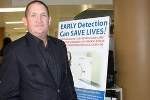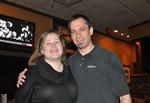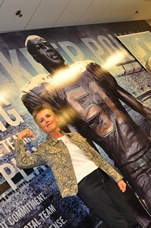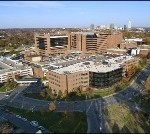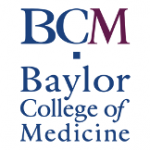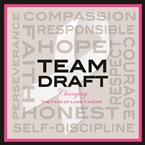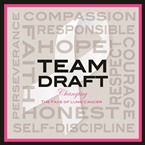 In 1998, I was diagnosed with stage IV lung cancer at the age of 15. I would later turn 16 in the hospital not knowing if I would live to see my 17th birthday.
In 1998, I was diagnosed with stage IV lung cancer at the age of 15. I would later turn 16 in the hospital not knowing if I would live to see my 17th birthday.
Being the son of a smoker (who through Gods grace has now quit), my initial thought was that secondhand smoke had something to do with my diagnosis. The doctors could never pinpoint the exact cause of my cancer but would later tell me it was probably acquired in utero and it just happened to lodge itself in my lungs. Whatever the case may be, I had cancer and needed to fight to see another birthday.
Through the power of prayer, family and medicine I was successfully treated with 4 rounds of chemotherapy and radiation treatment.
Before cancer became a turning point in my young life, I was just like any other teenager. I played sports, had friends and excelled in academics. Although I was administered an annual physical to play sports in school, it was never discovered that I had a malignant cancer slowly taking over my body.
Although I missed over a half a year of my junior high school year, I was able to graduate on time. I went on to graduate from college where I studied Psychology and minored in Spanish. I would even live as a missionary through my church for a year. I was soaking up as much as I could with this new lease on life.
As any cancer survivor would tell you, in the back of your mind, you initially feel you’re living on borrowed time. Once things settled down though, I started to reflect on my life and wanted to share it with someone and build a family of my own.
Meeting my wife, Yolanda and her struggle living with Asthma
I met my wife Yolanda during the summer of 2008 and we connected instantly when she shared with me that she suffered from Asthma since childhood.
In her own words:
As a child I never thought twice about running around and being a kid until I had my first asthma attack at the age of 9. I still remember how scared and helpless I felt as I tugged on my mom’s shirt to signal that I was having difficulties breathing. My mother, being asthmatic herself, was quick to assess the situation and rushed me to the emergency room. As a sat in the emergency room, hooked onto the nebulizer, I knew I wasn’t alone. Other kids were there getting the same treatment and innocently I believed that it was normal to be asthmatic. As the years went by I took my daily dose of medication to keep my asthma under control.
As a teenager I was overweight and continued my daily cocktails of medication for my asthma. By freshman year in high school I was 5’9″ and weighed 215lb. That same year the volleyball coach took interest in me and invited me to try out for the volleyball team, my first words were, “I can’t play volleyball, I’m asthmatic.” The coach looked at me and smiled, “You can still play, that’s not a problem at all.” I was offended that she didn’t think of my asthma as being a problem. After having that conversation all I thought about was playing volleyball, I wanted to play but was scared. I consulted with my mother who then made an appointment to speak to doctor. I could not believe he gave me the okay to play under close supervision and using my inhaler before any physical activity. It was difficult to train my body to run and jump because I had used my asthma as an excuse to get out of any physical activities.
After four years of volleyball, basketball, and softball I found myself using my inhaler less frequently. I dropped 40 pounds and felt great until one night I felt something I had not felt in a long time, an asthma attack. The asthma attack was progressively getting worse but I was in disbelief that this was happening again. As tears ran down my face, I walked up to my dad and simply said, “I can’t breath.” My father quickly took me to the hospital, where I was told that my asthma was now diagnosed as seasonal or mild asthma. I felt like I was back to square one again.
As a young adult, I started researching ways to strengthen my lungs. I came across an article in which I read that swimming was a great way to improve and possibly even cure asthma. The only problem was that, I didn’t know how to swim. I looked into local pools in my community and signed up for swimming lessons. What started out as a way to stay healthy ended up becoming a lifeguard and learning to help others.
For many years I used my asthma as a crutch to be less active and now as an adult, I have learned to keep my asthma in check. Asthma did not stop me from accomplishing my goals and becoming a better, healthier me.
Our lives together
We were married in July 2010 and are committed to living a healthy lifestyle both with diet and exercise. If it weren’t for diligent parents and caring health professionals we would not be here to share our story.
May 2012 will be 15 years since my lung cancer diagnosis and my wife hasn’t had an asthma attack in over 10 years. We are truly blessed and hope to encourage others to make their health, body and soul a priority in their lives.
Abraham and his wife Yolanda are from the Bronx, NY. Abraham graduated from Iona College in 2004, with a degree in Psychology and currently works for the Make-A-Wish Foundation of the Hudson Valley. Yolanda graduated from Lehman College with a degree in Speech Pathology and currently works for the Department of Education. She is currently completing her masters in teaching English to speakers of other languages – TESOL.
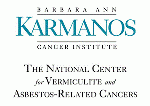 Gerold Bepler, M.D., Ph.D.
Gerold Bepler, M.D., Ph.D.

